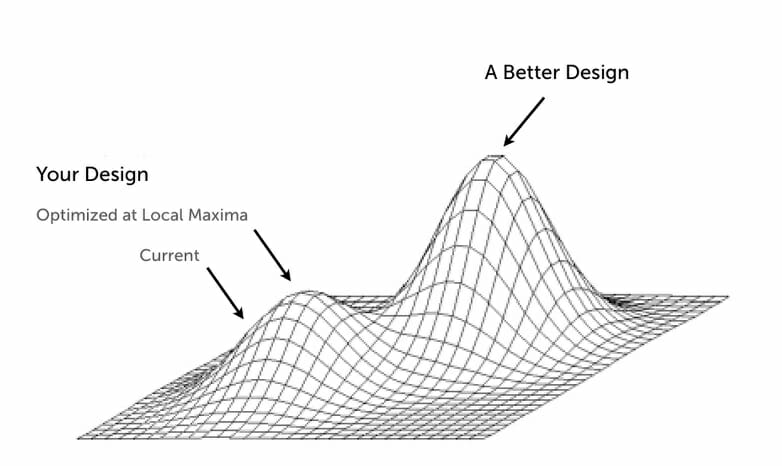We’re all trying to get better at business
By now there’s a good chance you’ve heard or read about a number of books that help you think about your business strategically. Depending on the market you’re in, as well as how much you like to read, there’s a good chance that you might have even read one of these books to help you run your business.
To be clear, it doesn’t matter if you run a consulting company, are a freelancer, or sell products in a particular market. The chances are good that at some point you decided to get outside advice to help you get better. Even if it wasn’t a book.
Here’s what else is likely. Some of the advice you read or heard was applicable. Some of it wasn’t. None of it was easy to directly apply unless the example you read or heard about was a direct match for what you’re doing.
Yet what if I were to tell you that there was an easier way to give you guidance without knowing any of your details? You’d likely not believe me. I get that.
But what if I were right?
Some very interesting research
Imagine a group of researchers at the Sloan School of Management (at MIT) had decided to create a business model taxonomy for companies. These could be broken out as four different kinds of business models:
- Creators
- Distributors
- Landlords
- Brokers
Now imagine if they further classified the assets involved:
- Financial
- Physical
- Intangible
- Human
You can start to see the grid of possibilities in this matrix, right? But what if they did more? Because they did, in a 2004 study.
What if they studied the top 1000 US firms, categorized them into this taxonomy, and then evaluated these businesses – without knowing the details of the businesses?
More importantly, what if they discovered that certain business models were more profitable than others? It would be worth knowing, wouldn’t it? Especially if there was a high correlation – suggesting that certain businesses were more interesting and enticing than others?
The reality is that they did do the research and did find that some business models were more profitable than others – consistently.
That means a lot to you and me because it suggests that we might be reading or getting advice on the “wrong” business model in the first place – especially if we want a nice business with great profit.
Wait, what is a business model, and why should we care?
A business model, in the simplest of terms, is an explanation of how you make money.
Another way to think about it is how you create value that a customer spends money to acquire.
Some people like to think about it as a value proposition, a formula for generating profit, a set of key processes, and a set of key assets. But that structure may lock you into a way of thinking that limits how you think about your business model.
In the end, I go back to the simplest definition – it explains how you make money (which is really more about how you get profit than revenue).
There are a lot of different kinds of business models, according to Professor Michael Rappa.
Until 2004 (and the MIT research), the reason you would care about a business model is because it suggested where there were opportunities for growth, or where there were levels to adjust performance. Business models let you “explore possibilities for future development.”
But that was then.
Since 2004, business models have demonstrated an excellent mechanism for not only classifying a business, but also predicting how well it might lead to profit.
Business model innovation, the wrong way
When we talk about business models and innovation, it’s easy to imagine that people want to find what levers exist and then want to know what happens when they start adjusting them. Again, I get that.
But that’s not always the most effective way to find or sustain business model innovation.
To understand what I’m talking about, let me reference this image – taken from a great article that describes a talk given by a talented Facebook product designer several years ago. The image actually comes from another article by Joshua Porter.
I know. That’s a lot of referencing for this image, but it’s important that you get the sources – even though they’re all related to design. Because this issue isn’t in any way related to design, and yet the image is still applicable.

A lot of times, people start adjusting their model and end up with the optimization that can be found at the local maxima. But that doesn’t mean it’s the best approach.
Instead, I find that one of the most valuable ways to create a change for a business is to
In other words, maybe you need to change your business model completely, which brings us right back to that MIT research.
Because they discovered that not all business models were equal. Some produce more profit than others, regardless of the details of that business itself.
Doesn’t that sound like something you’d want to know?
Check out Rent the Runway
When you check out Rent the Runway, and look at their about page, you discover these folks aren’t in the normal clothing business. They even tell you that.
They’ve decided to pursue the fashion industry in a different way, by changing the normal dynamics of the business model.
Instead of selling assets (in this case physical dresses), they’re renting them out.
The folks at MIT discovered that, “some business models do, indeed, perform better than others. Specifically, selling the right to use assets is more profitable and more highly valued by the market than selling ownership of assets.”
And Rent the Runway has figured that out.
They sell high-end dresses to women that wouldn’t normally have considered wearing them, and in so doing, they’re introducing a new segment of buyers to the market by letting them be renters. And they’re employing more data engineers than fashion designers.
Pretty amazing.
What does this mean for you and me?
As I said at the start, we are all trying to get better at business. And yet, sometimes we skip past the core parts of our business, our business model, because we just assume we won’t be changing anything dramatic.
The result is that we’re stuck going for simple and silly optimizations instead of stepping back and asking ourselves if there’s a better way to think about our business.
My challenge to the folks I coach is to regularly ask them to reflect on their business model as a whole. To ask themselves what business they’re really in, and to determine if there are better ways to serve their market segments.
What business are we in?
I’ll end with a silly example that you might relate to.
When I was a kid my parents bought the set of World Book encyclopedias. Several years later, Microsoft introduced a CD-ROM and followed it up with the pretty cruddy (but much less expensive) CD-ROM encyclopedia.
At the time, the Britannica and World Book folks thought they were in the business of delivering incredible knowledge to families everywhere. So they simply assumed that customers would choose them over the cruddy Encarta.
But they misunderstood what business they were in (in my opinion). They weren’t in the knowledge business at all. They were in the parenting business. Because parents bought these items to feel better about raising bright (or at least not raising non-bright) kids. And the moment they felt good about themselves with a $50 CD, they were done spending money on the larger sets like my folks had purchased.
In the end, I have to wonder if sometimes we’re all caught up with the momentum of our own previous decisions that we forget to step back and reevaluate what business we’re actually in.
As we do that work, it makes sense to me that we evaluate our business model and determine if another may work more effectively to deliver the value we want to deliver to the segments we want to work with.






